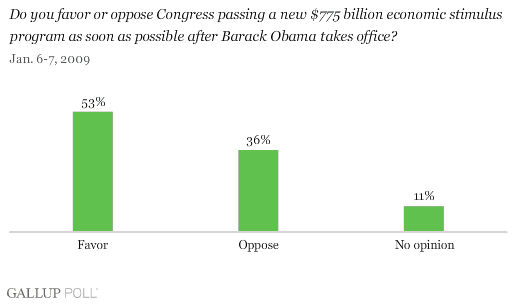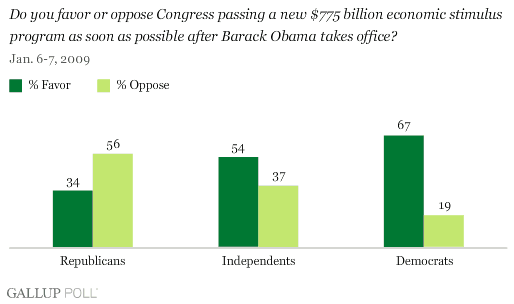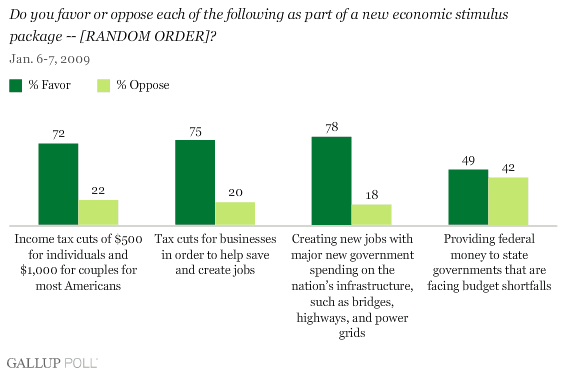PRINCETON, NJ -- New Gallup polling shows that 53% of Americans favor and 36% oppose Congress' passing a new $775 billion stimulus package of the type President-elect Barack Obama described in his Thursday speech on the economy. There is even higher support for specific elements it could include, such as major new government spending for infrastructure, income tax cuts, and tax incentives for businesses.

Questions asking Americans about a new stimulus plan were included in Gallup Poll Daily tracking Tuesday and Wednesday nights, just before Obama's Thursday speech in which he more formally proposed such a plan. The question wording included specific references to the cost of a new program ($775 billion), and the fact that it would be passed as soon as possible after Obama takes office. These explicit references to Obama may have had the effect of lowering overall support. Indeed, the breakout of support by partisanship shows that Republicans are much less likely than independents or Democrats to support the plan, perhaps foreshadowing the challenge Obama will have in convincing Republican lawmakers to go along with his proposal.

Most likely, this tepid response from Republicans represents both a typical conservative reluctance to increase government spending by such a large amount, as well as a negative reaction to the fact that the plan is being pushed by the Democratic president-elect.
Still, given that 11% of Americans interviewed don't have an opinion on the issue of the stimulus package, the results show that the measure "passes" by a 17-point margin (53% to 36%) when those in favor are compared to those opposed.
When Americans are asked about four different elements that are widely being discussed as part of the new stimulus bill (Obama has not yet put forth a highly specific proposal), support for three of the four is significantly higher than the overall level of support for the bill itself.

It is important to note that the wording of these specifics did not mention costs directly, perhaps making it easier for respondents to say they favored them. Also, the questions asking about spending more on infrastructure and providing tax incentives for businesses included references to the benefit from each in creating jobs, reminding respondents of potential positive outcomes.
As can be seen in the accompanying graph, support is highest for the idea of creating new jobs with "major new government spending on the nation's infrastructure," with slightly lower, but still very high, support for tax cuts for businesses ("to help save and create jobs") and income tax cuts for individuals and couples. Support is significantly lower for the idea of providing federal money to state governments that are facing budget shortfalls.
Implications
These data suggest first and foremost that Obama has the support of a majority of the American people in his attempt to prod Congress to pass a huge economic stimulus plan in the weeks after he takes office. Obama raised the stakes on passage of his plan on Thursday by warning that the economy could become "dramatically worse" if it doesn't pass.
The data also suggest -- from a marketing perspective -- that Obama and his team might be better off talking about the elements of his plan one by one rather than by focusing solely on the overall idea of spending huge amounts of money for a broad bill. In addition, Obama might note that the concept of giving federal money to state governments, if included in the final plan, appears to be the least popular. (Support could be higher if the benefits were more clearly defined in terms of either saving certain programs or keeping state taxes from rising.)
Obama does face resistance to his proposal from rank-and-file Republicans across the country, suggesting that it may not be smooth sailing for his bill when those who are pushing it come up against GOP members of the House and Senate.
Survey Methods
Results are based on telephone interviews with 972 national adults, aged 18 and older, conducted Jan. 6-7, 2009. For results based on the total sample of national adults, one can say with 95% confidence that the maximum margin of sampling error is ±3 percentage points.
Interviews are conducted with respondents on land-line telephones (for respondents with a land-line telephone) and cellular phones (for respondents who are cell-phone only).
In addition to sampling error, question wording and practical difficulties in conducting surveys can introduce error or bias into the findings of public opinion polls.
